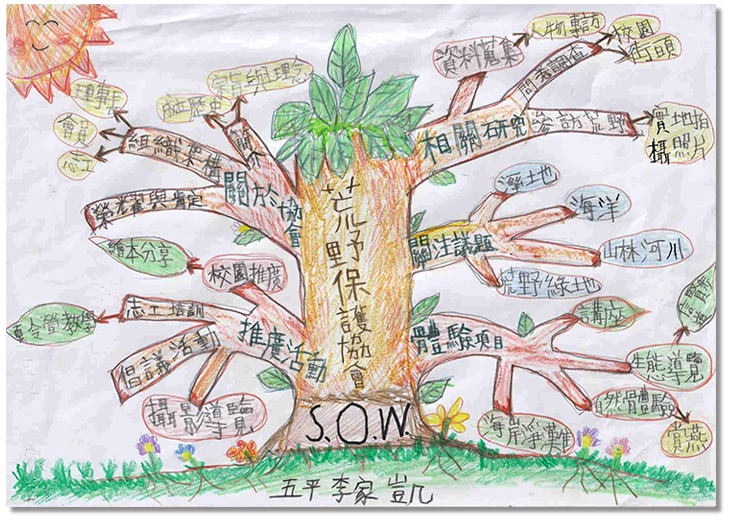Organized by Bo-Hsiang

Organized by Bo-Hsiang
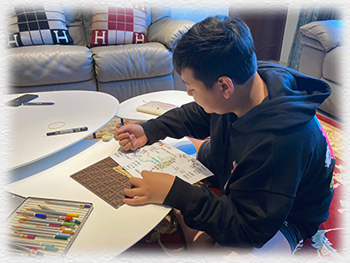 When doing a research project, my favorite part is drawing the mind map. The mind map can not only help us brainstorm ideas, but also help us to find the key focus of the project, which can enrich the project structure with more content. Through reading others’ mind maps, we can also understand others’ ideas more quickly, making our report more complete through brainstorming as a team.
When doing a research project, my favorite part is drawing the mind map. The mind map can not only help us brainstorm ideas, but also help us to find the key focus of the project, which can enrich the project structure with more content. Through reading others’ mind maps, we can also understand others’ ideas more quickly, making our report more complete through brainstorming as a team.
The main topic is the Society of Wilderness (SOW). Before I started making the mind map, I had researched online to learn about SOW. After gaining some basic understanding, I was able to outline the content and research methods in order, and I was also able to come up with some promotion ideas for more people to learn about SOW. For the drawings, I had chosen wetland as the main theme because of wetland’s ecosystem diversity. The theme had made the mind map more vivid with a stronger showing of the spirit of wilderness protection.
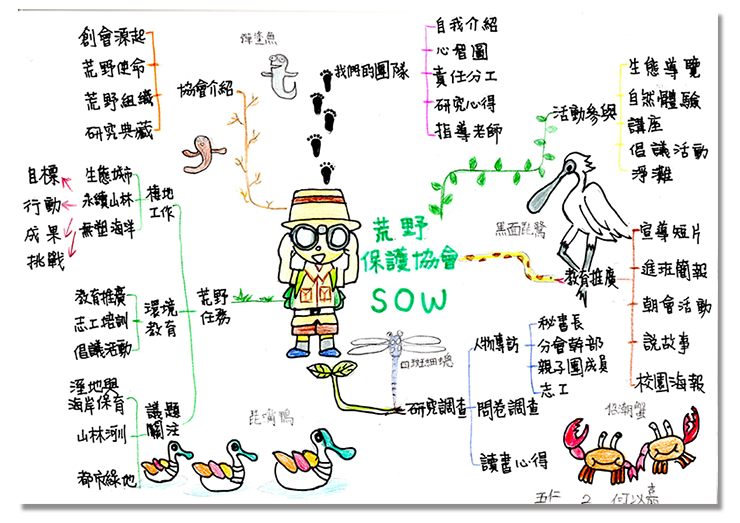
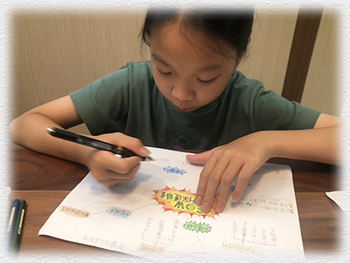 We picked “Society of Wilderness” as the topic for our research project and started constructing the website. The first step was to draw our mind maps. In the beginning, I thought SOW’s main mission was protecting the environment, so we originally had outlined categories such as air pollution, water resource management, protection of endangered species, etc. However, after we went through more information, we realized that SOW’s main focus is the wilderness, which covers rivers, oceans, mountains and forests, something that the general public has often neglected. Therefore, we changed our direction and started to focus on “habitat protection” (Wugu Wetland), “plastic-free ocean”, “sustainable mountain and forest, and “eco-city”.
We picked “Society of Wilderness” as the topic for our research project and started constructing the website. The first step was to draw our mind maps. In the beginning, I thought SOW’s main mission was protecting the environment, so we originally had outlined categories such as air pollution, water resource management, protection of endangered species, etc. However, after we went through more information, we realized that SOW’s main focus is the wilderness, which covers rivers, oceans, mountains and forests, something that the general public has often neglected. Therefore, we changed our direction and started to focus on “habitat protection” (Wugu Wetland), “plastic-free ocean”, “sustainable mountain and forest, and “eco-city”.
Through the tree diagram, I was able to create and work on more detailed sub-categories under each focus. For example, “habitat protection” was something we were not familiar with. However, we were able to visit the Wugu Wetland located near Taipei City to learn more about the habitat’s ecosystem. By learning about the history and development of the ecological park, I was able to know how SOW promotes and passes on its value through education, organization, and action.

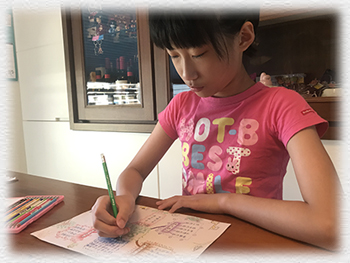 Mind Map is also known as brainstorming. It can be presented in many ways. Mind map visualizes and organizes concepts and ideas. For this project, the instructor asked us to use a mind map to present SOW’s organization, work content, missions, activities and events, etc. I began with browsing SOW’s official website, attending its seminar, and visiting its head office. My mind map includes six categories of get to know SOW, study the SOW, SOW missions, SOW experience, sharing and documenting.
Mind Map is also known as brainstorming. It can be presented in many ways. Mind map visualizes and organizes concepts and ideas. For this project, the instructor asked us to use a mind map to present SOW’s organization, work content, missions, activities and events, etc. I began with browsing SOW’s official website, attending its seminar, and visiting its head office. My mind map includes six categories of get to know SOW, study the SOW, SOW missions, SOW experience, sharing and documenting.
When learning about how to create and structure mind maps, I discovered that when I had encountered a new obstacle, the making of tree structure had made it easier for me to see the connection between each topic and category. This also made it easier to solve and overcome the obstacles. Through a brainstorming process, I was able to make problem solving more interesting and I was less afraid of unfamiliar problems. In addition, we could add illustrations to make the mind map lively and more interesting!

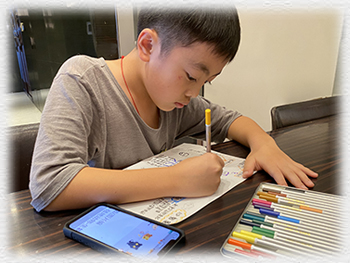 Mind map is a way for us to gain more understanding of the research project and a convenient way to browse the content quickly. However, it also requires detailed structure and clear outline of the research project. Therefore, prior to making the mind map, you must have a good understanding of the topic. If you don’t know the topic that well, you can start with conducting research for relevant information. Then you can list out the key points and start to extend your thoughts from each point to complete the mind map.
Mind map is a way for us to gain more understanding of the research project and a convenient way to browse the content quickly. However, it also requires detailed structure and clear outline of the research project. Therefore, prior to making the mind map, you must have a good understanding of the topic. If you don’t know the topic that well, you can start with conducting research for relevant information. Then you can list out the key points and start to extend your thoughts from each point to complete the mind map.
With the completion of the mind map, I had gained more insight about SOW. I also considered the mind map a great thing that can cut the work in half. The mind map can not only organize the issues I wanted to discuss, but also stimulated my inspirations and ideas. It is able to present the research project in a clear and simple way. By participating in this competition, I learned to utilize the mind map and organization skills, which had greatly improved our efficiency and allowed us to achieve our goals.
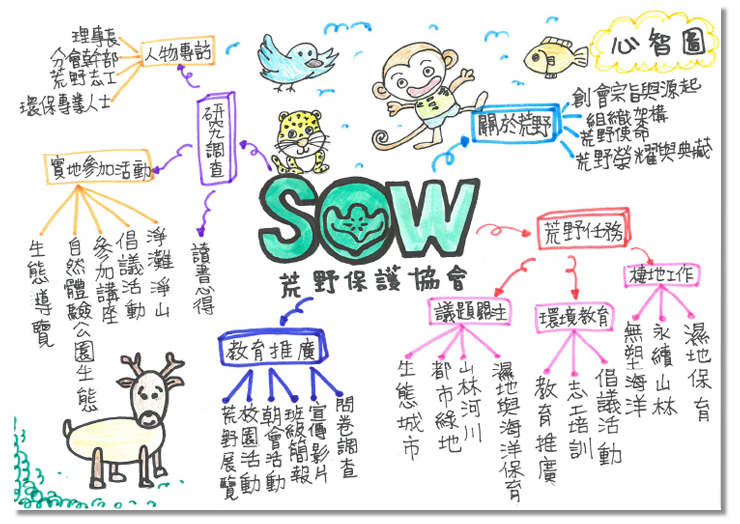
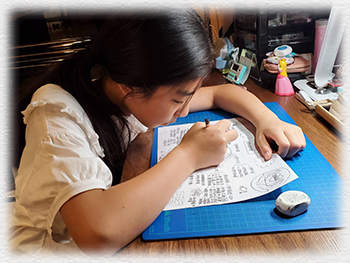 You must have a topic before you make the mind map. Starting with the topic and writing only keywords, then you can start making connections from keywords and expand the structure. This process can lead to more in-depth logical thinking and increase creativity and imagination. Each keyword has clear affiliation, which has allowed us to make clear and correct associations, and focus on the key points. The mind map can stimulate creativity and enhance memorization ability through identifying illustrations, colors, and keywords.
You must have a topic before you make the mind map. Starting with the topic and writing only keywords, then you can start making connections from keywords and expand the structure. This process can lead to more in-depth logical thinking and increase creativity and imagination. Each keyword has clear affiliation, which has allowed us to make clear and correct associations, and focus on the key points. The mind map can stimulate creativity and enhance memorization ability through identifying illustrations, colors, and keywords.
This is my first time making the mind map. I have only read other mind maps prior to this project. I thought the mind map would take more time to finish the project. However, after listening to the instructor, I realized that it actually saved me a lot of time. In the process of making the mind map, it helped to stimulate my brain. By connecting the keywords and key points, the mind map actually simplified the thinking process, which allowed me to easily map out and expand the structure. My take on this is that whenever there is a need to discuss or conduct research on a given topic or issue, the making of mind maps can provide assistance to the structural thinking of the entire project.
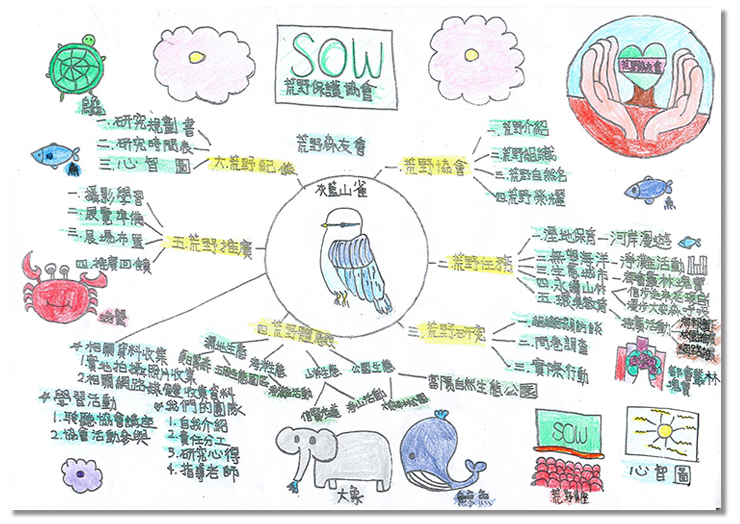
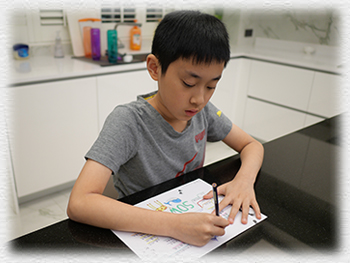 Mind map is a very useful tool that can help people to turn complicated articles into simple and clear diagrams. Mind maps can clearly present complex content, from the most basic title to the structure of the website. We made a mind map about the SOW. We extracted the organizational structure of the website, and then decided on the topics we want to introduce and the order in which the topics should be arranged. In this way, we can clearly know our project progress and track the unfinished tasks.
Mind map is a very useful tool that can help people to turn complicated articles into simple and clear diagrams. Mind maps can clearly present complex content, from the most basic title to the structure of the website. We made a mind map about the SOW. We extracted the organizational structure of the website, and then decided on the topics we want to introduce and the order in which the topics should be arranged. In this way, we can clearly know our project progress and track the unfinished tasks.
In the process of making our website, as each of us was assigned a complex and sizable amount of workload, it was very easy to lose track of our progress and responsibility. And that was when the mind map came in handy. It allowed us to see each team member’s responsibility at a glance. In addition to helping us to collect our thoughts, it also provided assistance in organizing our work and content. The mind map also served as a reference that allowed us to track our work progress during the making of the website.
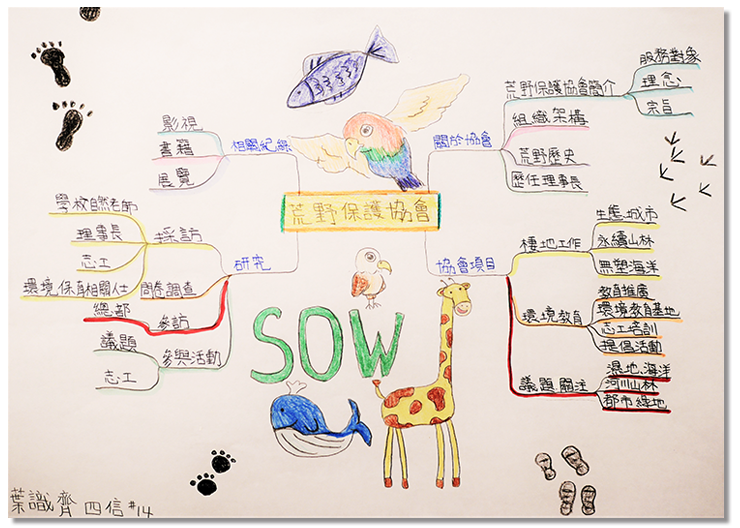
 We decided to pick the Society of Wilderness as our research project. SOW is a social organization that has devoted its effort in protecting Taiwan’s environment. The instructor had taught us to use mind maps to plan the project structure. Putting the topic in the center, branches can be developed, forming layers of tree diagrams. At the same time, keywords were used to record our thoughts and concepts. We were instructed to complete our own mind maps before we started to work on the project structure collaboratively. Making a mind map may seem easy, but it is no simple task. As SOW has focused on a wide range of environmental topics and participated in numerous events, it took me some time to research and collect information and read through several SOW volunteers’ blogs in order to gain more understanding of SOW. Then I could finally start doing my mind map and project planning.
We decided to pick the Society of Wilderness as our research project. SOW is a social organization that has devoted its effort in protecting Taiwan’s environment. The instructor had taught us to use mind maps to plan the project structure. Putting the topic in the center, branches can be developed, forming layers of tree diagrams. At the same time, keywords were used to record our thoughts and concepts. We were instructed to complete our own mind maps before we started to work on the project structure collaboratively. Making a mind map may seem easy, but it is no simple task. As SOW has focused on a wide range of environmental topics and participated in numerous events, it took me some time to research and collect information and read through several SOW volunteers’ blogs in order to gain more understanding of SOW. Then I could finally start doing my mind map and project planning.
When designing my mind map, my inspiration mainly came from the “wilderness” word of SOW. I used green leaves to represent mother nature at the bottom, and colorful flowers and rainbow background to represent biodiversity. I listed 6 categories for this research project: Wilderness Education, Wilderness Action, Wilderness Research, Wilderness Experience, Wilderness Promotion, and Project Progress. I hope that through this research project, the team and I can have in-depth understanding of SOW and participate in SOW activities together. By working as a team, I believe we can share our learning and reflection with each other. We can also promote SOW value to more people and protect the environment together.
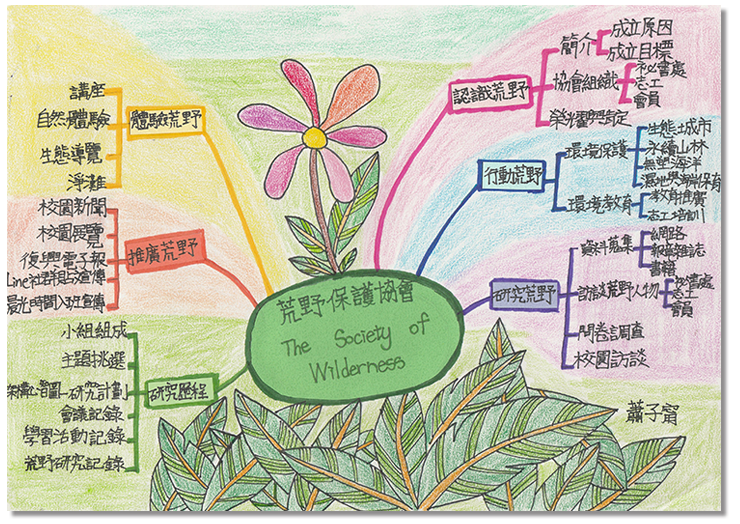
 I read many articles and stories about the Society of Wilderness on the internet. In order to be able to have a more systematic and efficient approach to understand SOW for the research project, the mind map is an efficient technique to help me organize my thoughts and provide more clear directions. Based on the information collected, I first categorized the four most common promotion models carried out by SOW: protection of Taiwan’s ecosystems, volunteer training, parent-child groups, and overseas branches. The four models are more closely related than one may expect.
I read many articles and stories about the Society of Wilderness on the internet. In order to be able to have a more systematic and efficient approach to understand SOW for the research project, the mind map is an efficient technique to help me organize my thoughts and provide more clear directions. Based on the information collected, I first categorized the four most common promotion models carried out by SOW: protection of Taiwan’s ecosystems, volunteer training, parent-child groups, and overseas branches. The four models are more closely related than one may expect.
From the start, SOW’s main mission has been helping nature to restore its ecological environment. Therefore, it has been hosting various activities and events to get people to know nature, allowing people to develop a deeper connection to the natural environment. This has been the most effective environmental education method recognized by SOW. In order to gain more recognition from more people, SOW has decided to offer training courses for its volunteers, fostering volunteers with expertise in different fields. With the paths shown in the mind map, I can clearly see SOW’s operation patterns. This is the SOW that we are seeing, an organization committed to protecting the environment and providing environmental education at the same time.

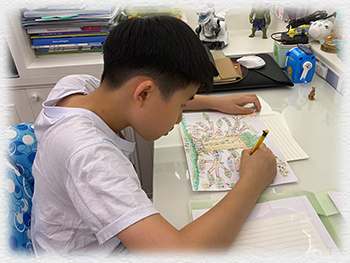 I researched and collected data about the Society of Wilderness and categorized its works into five categories: About SOW, Promotional Activities, Relative Research, Environmental Issues, and Activity Experience.
I researched and collected data about the Society of Wilderness and categorized its works into five categories: About SOW, Promotional Activities, Relative Research, Environmental Issues, and Activity Experience.
In the mind map, I used a big tree to represent SOW, and the achievements were presented through the tree branches. I placed the big tree on a green field and hoped that it would make the world even greener. We could also learn how to protect mountains, forests, wetlands, and oceans from the big tree.
